HONDA CB1000R User Manual

Honda
CB1000R/RA
OWNER’S MANUAL
MANUAL DEL PROPIETARIO
MANUAL DO PROPRIETÁRIO
© Honda Italia Industriale S.p.A. 2008
IMPORTANT INFORMATION
•OPERATOR AND PASSENGER
This motorcycle is designed to carry the operator and one passenger, never exceed the maximum weight capacity as shown on the accessories and loading label.
•ON-ROAD USE
This motorcycle is designed to be used only on the road.
•READ THIS OWNER'S MANUAL CAREFULLY
Pay special attention to the safety messages that appear throughout the manual. These messages are fully explained in the “A Few Words About Safety” section which appears before the Contents page.
This manual should be considered a permanent part of the motorcycle and should remain with the motorcycle when resold.

Honda CB1000R/RA
OWNER’S MANUAL
CB1000R |
CB1000RA |
All information in this publication is based on the latest production information available at the time of approval for printing. Honda Italia Industriale S.p.A. reserves the right to make changes at any time without notice and without incurring any obligation. No part of this publication may be reproduced without written permission.

WELCOME
The motorcycle presents you a challenge to master the machine, a challenge to adventure. You ride through the wind, linked to the road by a vehicle that responds to your commands as no other does. Unlike an automobile, there is no metal cage around you. Like an airplane, a preride inspection and regular maintenance are essential to your safety. Your reward is freedom.
To meet the challenges safely, and to enjoy the adventure fully, you should become thoroughly familiar with this owner's manual BEFORE YOU RIDE THE MOTORCYCLE.
As you read this manual, you will find information that is preceded by a NOTICE symbol.
This information is intended to help you avoid damage to your motorcycle, other property, or the environment.
When service is required, remember that your Honda dealer knows your motorcycle best. If you have the required mechanical “know-how” and tools, your dealer can supply you with an official Honda Service Manual to help you perform many maintenance and repair tasks.
Pleasant riding, and thank you for choosing a Honda!
•The illustrations here in are based on the CB1000R/RA.
•Following codes in this manual indicate each country.
|
CB1000R/RA |
E |
UK |
|
|
F |
France |
ED |
European direct sales |
U |
Australia, New Zealand |
• The specifications may vary with each locale.
A FEW WORDS ABOUT SAFETY
Your safety, and the safety of others, is very important, and operating this motorcycle safely is an important responsibility.
To help you make informed decisions about safety, we have provided operating procedures and other information on labels and in this manual. This information alerts you to potential hazards that could hurt you or others.
Of course, it is not practical or possible to warn you about all hazards associated with operating or maintaining a motorcycle. You must use your own good judgment.
You will find important safety information in a variety of forms, including:
•Safety Labels - on the motorcycle.
•Safety Messages - preceded by a safety alert symbol n and one of three signal words:
DANGER, WARNING or CAUTION.
These signal words mean:
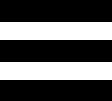
n DANGER
n WARNING
n CAUTION
You WILL be KILLED or SERIOUSLY HURT if you don’t follow instructions.
You CAN be KILLED or SERIOUSLY HURT if you don't follow instructions.
You CAN be HURT if you don't follow instructions.
•Safety Headings - such as Important Safety Reminders or Important Safety Precautions.
•Safety Section - such as Motorcycle Safety.
•Instructions - how to use this motorcycle correctly and safely.
This entire manual is filled with important safety information - please read it carefully.

0 OPERATION
Index
Page
11 MOTORCYCLE SAFETY
1 Important safety information
2 Protective apparel
4 Load Limits and Guidelines
28 PARTS LOCATION
14 Instruments and Indicators
334 MAJOR COMPONENTS
(Information you need to operate this
motorcycle) 34 Suspension 39 Brakes
42 Clutch
44 Coolant
47 Fuel
50Engine Oil
51Tubeless Tyres
457 ESSENTIAL INDIVIDUAL COMPONENTS
57 Ignition Switch
58 Keys
60 Immobilizer System (HISS)
63 Right Handlebar Controls
64 Left Handlebar Controls
Page
5 66 FEATURES
(Not required for operation)
66Steering lock
67Seat
68Helmet Holder
69Storage compartment for U-shaped anti-theft lock
70Document compartment
71Luggage Tie-Down Hooks
72Side cover
73Headlight aim vertical adjustment
674 OPERATION
74 Pre-ride Inspection
76 Starting the Engine
79 Running-in
80 Riding
81 Braking
85 Parking
86 Anti-theft Tips

MAINTENANCE
Page |
|
Page |
|
7 87 |
MAINTENANCE |
8 139 |
CLEANING |
87 |
The importance of Maintenance |
9 143 |
STORAGE GUIDE |
88 |
Maintenance Safety |
||
89 |
Safety precautions |
143 |
Storage |
90 |
Maintenance Schedule |
145 |
Removal from Storage |
93 |
Tool kit |
10 146 |
SPECIFICATIONS |
94 |
Serial Numbers |
||
95 |
Colour Label |
11 150 |
CATALYTIC CONVERTER |
96 |
Engine Oil |
101Crankcase Breather
102Spark Plugs
103Throttle Operation
104AirCleaner
106Coolant
107Drive Chain
112Drive Chain Slider
113Front and Rear Suspension Inspection
114Side Stand
115Wheel Removal
125 Brake Pad Wear
127 Battery
129 Fuse replacement
132Brake lights switch adjustment
133Bulb replacement
0
Index

MOTORCYCLE SAFETY
IMPORTANT SAFETY INFORMATION
Your motorcycle can provide many years of service and pleasure - if you take responsibility for your own safety and understand the challenges that you can meet on the road.
There is much that you can do to protect yourself when you ride. You’ll find many helpful recommendations throughout this manual. Following are a few that we consider most important.
Always Wear a Helmet
It’s a proven fact: Helmets significantly reduce the number and severity of head injuries. So always wear an approved motorcycle helmet and make sure your passenger does the same. We also recommend that you wear eye protection, sturdy boots, gloves and other protective gear (page 2).
Make Yourself Easy to See
Some drivers do not see motorcycles because they are not looking for them. To make yourself more visible, wear bright reflective clothing, position yourself so other drivers can see you, signal before turning or changing lanes, and use your horn when it will help others notice you.
Ride Within Your Limits
Pushing the limits is another major cause of motorcycle accidents. Never ride beyond your personal abilities or faster than conditions warrant. Remember that alcohol, drugs, fatigue and inattention can significantly reduce your ability to make good judgements and ride safety.
1
Motorcycle Safety
1
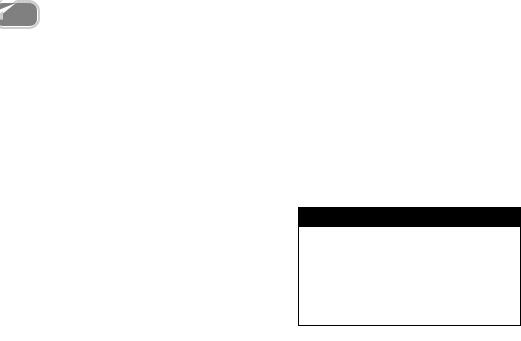
1
Motorcycle Safety
Keep Your Bike in Safe Condition
For safe riding, it’s important to inspect your motorcycle before every ride and perform all recommended maintenance. Never exceed load limits, and only use accessories that have been approved by Honda for this motorcycle. See page 4 for more details.
Don’t drink and ride
Alcohol and riding don’t mix. Even one drink can reduce your ability to respond to changing conditions, and your reaction time gets worse with every additional drink. So don’t drink and ride, and don’t let your friends drink and ride either.
PROTECTIVE APPAREL
For your safety, we strongly recommend that you always wear an approved motorcycle helmet, eye protection, boots, gloves, long trousers and a long-sleeved shirt or jacket whenever you ride. Although complete protection is not possible, wearing proper gear can reduce the chance of injury when you ride.
Following are suggestions to help you choose proper gear.
n WARNING
Not wearing a helmet increases the chance of serious injury or death in a crash.
Be sure you and your passenger always wear a helmet, eye protection and other protective apparel when you ride.
2

Helmets and Eye Protection
Your helmet is your most important piece of riding gear because it offers the best protection against head injuries. A helmet should fit your head comfortably and securely. A bright-coloured helmet can make you more noticeable in traffic, as can reflective strips.
An open-face helmet offers some protection but a full-face helmet offers more. Always wear a face shield or goggles to protect your eyes and help your vision.
Additional Riding Gear
In addition to a helmet and eye protection, we also recommend:
•Sturdy boots with non-slip soles to help protect your feet and ankles.
•Leather gloves to keep your hands warm and help prevent blisters, cuts, burns and bruises.
•A motorcycle riding suit or jacket for comfort as well as protection. Bright-coloured and reflective clothing can help make you more noticeable in traffic. Be sure to avoid loose clothes that could get caught on any part of your motorcycle.
1
Motorcycle Safety
3
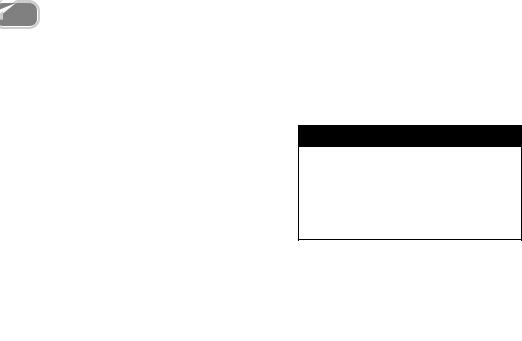
1
Motorcycle Safety
LOAD LIMITS AND GUIDELINES
Your motorcycle has been designed to carry you and one passenger. When you carry a passenger, you may feel some difference during acceleration and braking. But so long as you keep your motorcycle well maintained, with good tyres and brakes, you can safely carry loads within the given limits and guidelines.
However, exceeding the weight limit or carrying an unbalanced load can seriously affect your motorcycle's handling, braking and stability. Non-Honda accessories, improper modifications, and poor maintenance can also reduce your safety margin.
The following pages give more specific information on loading, accessories and modifications.
Loading
How much weight you put on your motorcycle, and how you load it, are important to your safety. Anytime you ride with a passenger or cargo you should be aware of the following information.
n WARNING
Overloading or improper loading can cause a crash and you can be seriously hurt or killed.
Follow all load limits and other loading guidelines in this manual.
4

Load Limits
Following are the load limits for your motorcycle:
Maximum weight capacity:
188 kg (415 lbs)
Includes the weight of the rider, passenger, all cargo and all accessories.
Maximum cargo weight:
27 kg (60 lbs)
The weight of added accessories will reduce the maximum cargo weight you can carry.
Loading Guidelines
Your motorcycle is primarily intended for transporting you and a passenger. You may wish to secure a jacket or other small items to the seat when you are not riding with a passenger.
If you wish to carry more cargo, check with your Honda dealer for advice, and be sure to read the information regarding accessories on page 6.
Improperly loading your motorcycle can affect its stability and handling. Even if your motorcycle is properly loaded, you should ride at reduced speeds and never exceed 130 km/h (80 mph) when carrying cargo.
Follow these guidelines whenever you carry a passenger or cargo:
•Check that both tyres are properly inflated.
•If you change your normal load, you may need to adjust the front and rear suspension (pages 34-37).
•To prevent loose items from creating a hazard, make sure that all cargo is securely tied down before you ride away.
•Place cargo weight as close to the center of the motorcycle as possible.
•Balance cargo weight evenly on both sides.
•To avoid possible heat damage to your motorcycle or personal belongings, do not block or restrict air flow around the exhaust muffler with baggage or clothing.
1
Motorcycle Safety
5
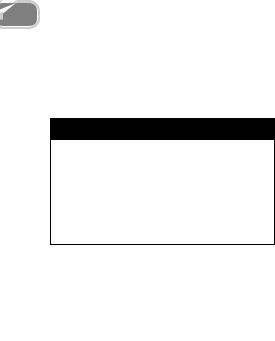
1
Motorcycle Safety
Accessories and Modifications
Modifying your motorcycle or using nonHonda accessories can make your motorcycle unsafe. Before you consider making any modifications or adding an accessory, be sure to read the following information.
n WARNING
Improper accessories or modifications can cause a crash in which you can be seriously hurt or killed.
Follow all instructions in this owner’s manual regarding accessories and modifications.
Accessories
We strongly recommend that you use only genuine Honda accessories that have been specifically designed and tested for your motorcycle. Because Honda cannot test all other accessories, you must be personally responsible for proper selection, installation and use of non-Honda accessories. Check with your dealer for assistance and always follow these guidelines:
•Make sure the accessory does not obscure any lights, reduce ground clearance and banking angle, limit suspension travel or steering travel, alter your riding position or interfere with operating any controls.
•Be sure electrical equipment does not exceed the motorcycle's electrical system capacity (page 149). A blown fuse can cause a loss of lights or engine power.
6

•Do not pull a trailer or sidecar with your motorcycle. This motorcycle was not designed for these attachments and their use can seriously impair your motorcycle’s handling.
•We remind you that Honda produces a wide range of genuine accessories in order to improve your comfort and use of the motorcycle.
Consult your Honda dealer for more details and informations. (Only type E, F, ED)
Modifications
We strongly advise you not to remove any original equipment or modify your motorcycle in any way that would change its design or operation. Such changes could seriously impair your motorcycle's handling, stability and braking, making it unsafe to ride.
Removing or modifying your lights, mufflers, emission control system or other equipment can also make your motorcycle illegal.
1
Motorcycle Safety
7
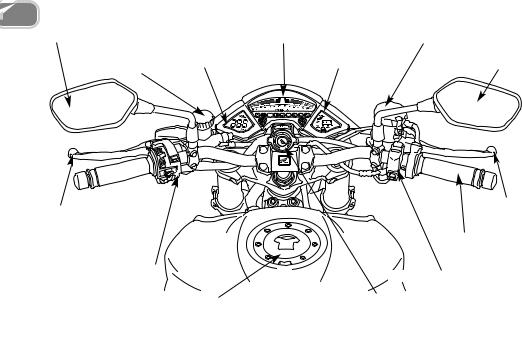
1
Motorcycle Safety
PARTS LOCATION TYPE CB1000R
Rearview |
Speedometer |
Tachometer |
Front brake fluid reservoir |
||||
mirror |
Coolant |
Indicators |
|||||
Rearview |
|||||||
Clutch fluid |
temperature |
Multifunction display |
|||||
reservoir |
indicator |
mirror |
|||||
|
|
|
|
|
|
|
|
|
|
|
|
|
|
|
|
Front
Clutch lever |
|
brake lever |
|
|
|
|
|
Throttle grip |
Left handlebar controls |
|
Right handlebar controls |
|
|
|
|
Fuel fill cap |
Ignition switch |
|
|
8
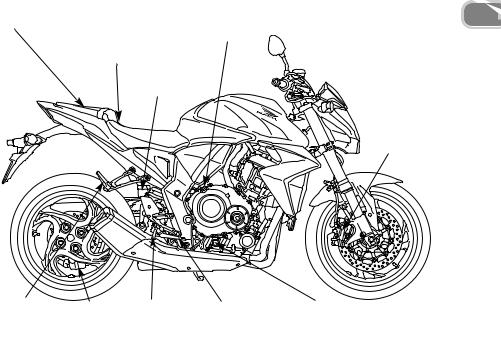
Tool kit |
Battery |
|
|
Fuse Boxes |
Oil filler cap |
|
Main fuse |
|
|
FI fuse |
|
|
Rear brake fluid |
|
|
reservoir |
|
Right radial brake caliper assembly
1
Motorcycle Safety
Passenger |
Rear brake |
Footpeg |
Rear brake |
Engine oil |
footpeg |
caliper |
|
pedal |
inspection window |
9
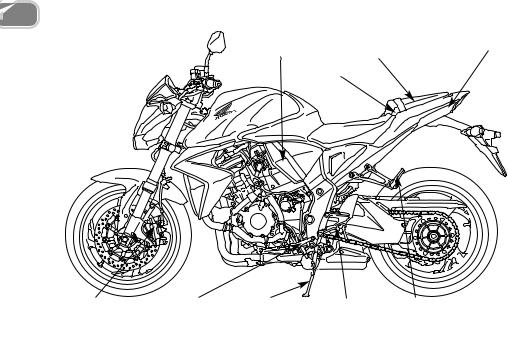
1
Motorcycle Safety
Air cleaner |
Document |
Seat lock |
|
compartment |
|||
|
|||
|
Helmet holder |
|
Left radial brake |
Gearshift |
Side stand |
Footpeg |
Passenger footpeg |
caliper assembly |
lever |
|
|
|
10
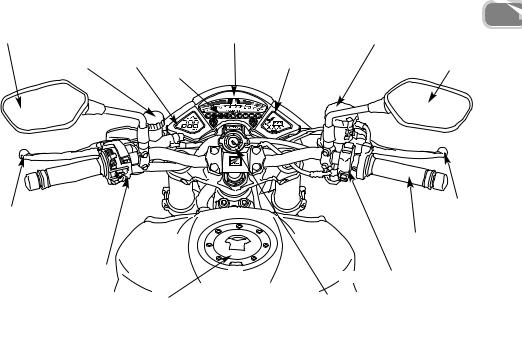
PARTS LOCATION TYPE CB1000RA
Rearview |
Speedometer |
Tachometer |
|||
mirror |
Coolant |
Indicators |
|||
Clutch fluid |
temperature |
|
|
|
|
reservoir |
indicator |
Multifunction display |
|||
|
ABS indicator |
||||
|
|
|
|
|
|
|
|
|
|
|
|
Clutch lever
Front brake fluid reservoir Rearview mirror
Front brake lever
Throttle grip
Left handlebar controls |
|
Right handlebar controls |
|
|
|
|
Fuel fill cap |
Ignition switch |
|
|
2
Parts Location
11
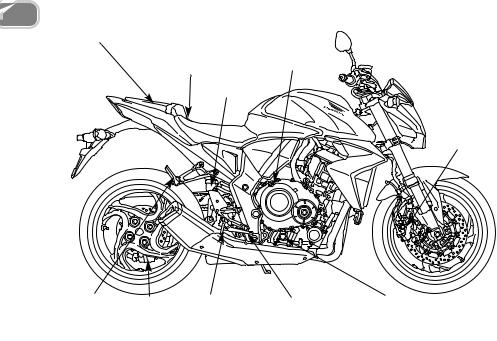
2
Parts Location
Tool kit |
Battery |
|
|
Fuse Boxes |
|
|
Main fuse |
Oil filler cap |
|
FI fuse |
|
|
|
|
|
Rear brake fluid |
|
|
reservoir |
|
ABS-CBS Right brake
caliper assembly
Passenger |
ABS-CBS |
Footpeg |
Rear brake |
Engine oil |
footpeg |
Rear brake caliper |
|
pedal |
inspection window |
12
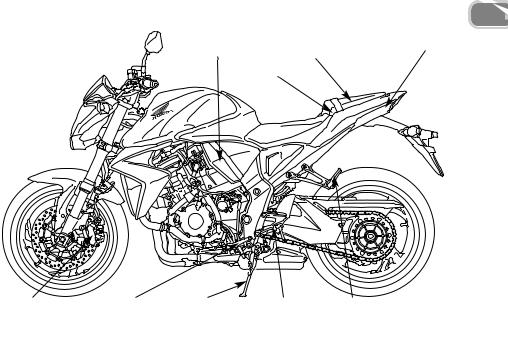
Air cleaner |
Document |
Seat lock |
|
compartment |
|||
|
|||
|
Helmet holder |
|
2
Parts Location
ABS-CBS Left brake |
Gearshift |
Side stand |
Footpeg |
Passenger footpeg |
caliper assembly |
lever |
|
|
|
13

2 |
(1) |
Parts Location |
|
(2)
(3)
(4) |
(5) |
(6) |
(7) (8) (9) (10) (11) (12)(13)(14) (15) |
INSTRUMENTS AND INDICATORS |
(7) |
PGM-FI indicator |
|
The indicators are contained in the instrument |
(8) |
ABS indicator (CB1000RA) |
|
panel. Their functions are described in the |
(9) |
Immobilizer system (HISS) indicator |
|
tables on the following pages. |
(10) |
Low oil pressure indicator |
|
INSTRUMENT |
(11) |
Neutral indicator |
|
(12) |
High beam indicator |
||
(1) |
Tachometer |
(13) |
RESET button |
(2) |
Red zone tachometer |
(14) |
Coolant temperature indicator |
(3) |
Multifunction display |
(15) |
Right turn signal indicator |
(4)Speedometer/temperature meter display
(5)Left turn signal indicator
(6)SET button
14

(Ref. Nr.) Description |
|
|
Function |
|
|
|
|
(1) Tachometer |
|
Shows engine revolutions per minute. |
|
|
|
The tachometer graduated will swing to the maximum |
|
|
|
scale on the dial once when the ignition switch is |
|
|
|
turned ON. |
|
|
|
|
|
(2) Red zone tachometer |
|
Never allow the tachometer graduated to enter the red |
|
|
|
zone, even after the engine has been broken in. |
|
|
|
|
|
|
|
NOTICE |
|
|
|
|
|
|
|
Running the engine beyond recommended maximum |
|
|
|
engine speed (the beginning of the tachometer red |
|
|
|
zone) can damage the engine. |
|
|
|
|
|
2
Parts Location
15

2
Parts Location
|
|
(Ref. Nr.) Description |
Function |
|
|
|
|
(3) Multi-function display |
The display includes the following functions; |
||
|
|
|
This display shows the initial display (page 22). |
|
|
|
|
|
- |
Fuel indicator |
Shows approximate fuel supply available. |
|
|
|
Lights when tank fuel level is low (page 24). |
|
|
|
|
|
- |
Digital clock |
Shows hour and minute (page 31) |
|
|
|
|
|
- |
Odometer |
Indicates the total mileage (page 28). |
|
|
|
|
|
- |
Tripmeter |
Indicates partial mileage (page 29). |
|
|
|
|
|
- Modifying speed unit and mileage |
Modifying speed unit and mileage covered from |
|
|
|
covered (E type only) |
Kilometers to Mph and vice versa(E type only) (page 33). |
|
|
|
|
16

|
(Ref. Nr.) Description |
Function |
|
|
|
(4) Speedometer/temperature |
The display includes the following functions; |
|
meter display |
This display shows the initial display (page 22). |
|
|
|
|
|
- Speedometer |
Indicates riding speed (page 28). |
|
|
Shows speed in kilometres per hour (km/h) or miles |
|
|
per hour (mph) according to the model. |
|
|
|
|
- Coolant temperature meter |
Shows coolant temperature (page 26). |
|
|
|
|
- Modifying speed unit and mileage |
Modifying speed unit and mileage covered from |
|
covered (E type only) |
Kilometers to Mph and vice versa(E type only) (page 33). |
|
|
|
2
Parts Location
17

2
Parts Location
(Ref. Nr.) Description |
|
Function |
|
|
|
(5) Left turn signal indicator(green) |
Flashes when the left turn signal operates. |
|
|
|
|
(6) SET button |
Use this button for the following purposes. |
|
|
• To adjust time. |
|
|
• This button is used to select the following mode: |
|
|
ODOMETER - TRIP1TRIP2. |
|
|
• To adjust light brightness display. |
|
|
• To change unit of speedometer, odometer and |
|
|
tripmeter (E type only)(page 33). |
|
|
|
|
(7) PGM-FI malfunction indicator lamp |
Lights when there is any abnormality in the PGM-FI |
|
(amber) |
(Programmed Fuel Injection) system. |
|
|
It should also light for a few seconds and then go off |
|
|
when the ignition switch is turned ON and engine stop |
|
|
switch is at |
(RUN). |
|
If it comes on at any other time, reduce speed and |
|
|
take the motorcycle to your Honda dealer as soon as |
|
|
possible. |
|
|
|
|
18

(Ref. Nr.) Description |
|
Function |
|
|
|
(8) Anti-lock brake system (ABS) indicator |
This indicator light normally illuminates when the |
|
light (amber) (CB1000RA) |
ignition switch is set to ON and is extinguished when |
|
|
the motorcycle is ridden at a speed of more than 10 |
|
|
km/h (6 mph). In the event of problems with the ABS |
|
|
system this indicator flashes and remains on (page |
|
|
84). |
|
|
|
|
(9) Immobilizer system (HISS) indicator |
This indicator lights for a few seconds when the |
|
(red) |
ignition switch is turned ON and the engine stop |
|
|
switch is at |
(RUN). It will go off if the properly- |
|
coded key has been inserted. If an improperly-coded |
|
|
key has been inserted, the indicator will remain on |
|
|
and the engine will not start (page 60). |
|
|
When the blinking function of this indicator is valid |
|
|
and the ignition switch is off, it keeps blinking for 24 |
|
|
hours (page 60). |
|
|
|
|
2
Parts Location
19

2
Parts Location
(Ref. Nr.) Description |
|
|
Function |
|
|
|
|
(10) Low oil pressure indicator (red) |
Lights when the engine oil pressure is below normal |
||
|
operating range. Should light when ignition switch is |
||
|
ON and engine is not running. Should go out when the |
||
|
engine starts, except for occasional flickering at or |
||
|
near idling speed when engine is warm. |
||
|
|
|
|
|
|
NOTICE |
|
|
|
|
|
|
Running the engine with insufficient oil pressure may |
||
|
cause serious engine damage. |
||
|
|
|
|
(11) Neutral indicator (green) |
Lights when the transmission is in neutral. |
||
|
|
|
|
(12) High beam indicator (blue) |
Lights when the headlight is on high beam. |
||
|
|
||
(13) RESET button |
Use this button for the following purposes. |
||
|
• To adjust time. |
||
|
• To reset tripmeter |
||
|
• To adjust light brightness display. |
||
|
• To change unit of speedometer, odometer and |
||
|
|
tripmeter (E type only)(page 33). |
|
|
|
|
|
20
